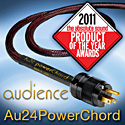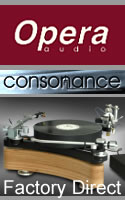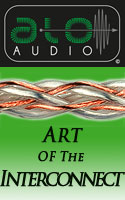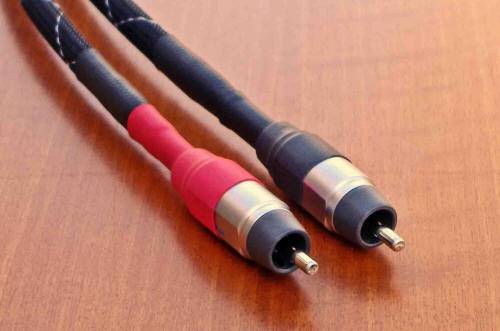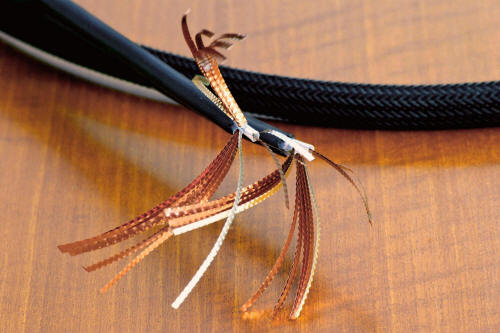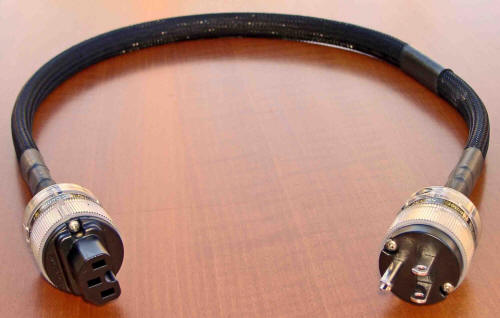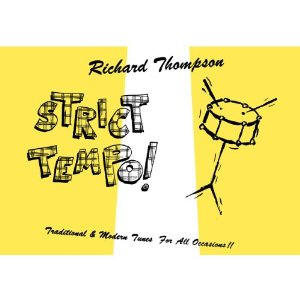|
|
You are reading the older HTML site
Positive Feedback ISSUE 59
grover huffman a Complete Line of Cables as reviewed by Tom Campbell
Most of my early reviews for Positive Feedback Online were of relatively low-cost speaker cables and interconnects. From about 2002 to 2005 I auditioned a series of them, including several from start-up do-it-yourself ventures. A quick Google search confirmed that almost all of these companies are still in operation, each maintaining a dedicated group of followers. Given the attrition rate in the industry over the past several years, this came as a bit of a surprise. But it wasn't exactly a shock: all of the designs I reviewed during those year ranged from good to excellent and pointed to the high performance that can be found in the audiophile cable market without spending silly amounts of money. A notable aspect of most of the communications I've had with cable designers over the years is the intense seriousness with which they approach their business. Cynical observers often regard cables as an epicenter of audio charlatanism—after all, making wires that conduct a signal is literally a matter of child's play. But making that signal get from one end to the other with maximum fidelity involves a great deal of skill, and it is clear in speaking with the proprietors of these companies that they bring considerable technical knowledge and ability to the table, and each one can and will provide passionate testimony regarding the uniqueness of his own design, and how that makes his cables superior to those of competitors. If you deal with them directly, there is simply no mistaking their enthusiasm or sincerity. Grover Huffman is among the best-known of the DIY cable designers. His name is spoken with hushed reverence over at the Steve Hoffman Forum—a lively audiophile discussion board maintained by the re-mastering ace of Music Matters, Analogue Productions and Audio Fidelity fame—and Hoffman himself has provided testimonials to Huffman's designs. Huffman's particular (and patented) breakthrough, as he explains it, is to "incorporate my painstakingly designed state-of-the-art carbon nickel shield that neutralizes Electro-magnetic influences on the signal both from within and without, resulting in the cleanest, focused signal regardless of price… (S)kin effect is completely eliminated, and conductor surface area greatly enhanced." Huffman is a tireless perfectionist who spends years developing and tweaking his products. In fact, I was scheduled to review his latest offerings more than two years ago but Grover decided to pull back at the time. That was October of 2009. So imagine my surprise to receive this one-line email in October of 2011: "Hi Tom, long time but I've perfected my cables. Would you still be interested in hearing them? Best Always, Grover Huffman" Would I be interested? Without hesitation, I replied "Absolutely." While I had a revolving door of cable products in my system for a number of years, it happens that the Huffmans are the first new ones I've reviewed in some time. For quite a while, my system used interconnects, power cords and speaker cables from a small outfit called My Audio Cables (usually abbreviated as MAC). The MACs are where I landed after auditioning many brands back in the early and mid-'00s, and I have always found them to be clean, even and accurate across the frequency spectrum, if just a bit softened at the top end. About a year ago, I replaced the speaker cables with a pair of Audio Note Lexus copper cables, which brought a slightly cooler balance, but greater clarity and depth to my system's performance. A brief anecdote: when auditioning another product recently, I found myself needing a slightly longer cable connection and pulled out a long-retired pair of silver interconnects for the purpose. At the time I got them, probably around 2001, they were the most expensive cables I'd ever bought; as I recall, $500 or $600 for a 1.5 meter pair. They sounded great in a brief showroom audition. But after a short time in my home system, I found that the effect quickly palled and that the cables were adding a harsh edge to the overall sound. They went into a box in my basement, and I had never used them again until now. When I put them back into my system, I was curious to see if my impressions would be different now than they were then. My current system—Ayon Audio all-tube integrated amp, Bel Canto universal digital player, Nottingham turntable— is anything but cold and clinical. But as it turned out, the cables' effects were even worse than I remembered; they made everything sound overwhelmingly hard and glassy. I ran them in overnight and stuck with them for at least two or three more days, but quickly realized that things were not going to change for the better. The experience was a vivid reminder of the importance of cables in a good system, and how important they are to helping your components really sound and perform at their best. Huffman sent me a full complement of wires: one pair of interconnects (for my CD player-to-amplifier connection; my Nottingham turntable has captive connectors), two power cords and a pair of speaker cables. The Huffman speaker cables are terminated with bare copper—in my case a pair of thin, stiff-but-bendable rods, about 3" long, at each end. Huffman is willing to terminate with spades or banana plugs for a small added fee, but feels that his speaker cables perform best with bare wire.
Huffman's line consists of just one interconnect ($200 for a one-meter pair, $280 for 2 meters), one power cord ($300 for a three-foot cord, $350 for six feet) and one speaker cable ($40 per foot pair single-wire, $75 for bi-wire), eschewing the common approach of multiple models with tiered pricing. The ostensible idea is that you get his one, level-best effort with each product, and needn't feel the compulsion to upgrade down the road (or conversely, to feel that you're missing out on untold audio greatness by not buying the most expensive offering in the line). I have to say that I like this philosophy very much. Auditioning multiple items is always a bit of a challenge—I feel the best way to go about it is to introduce one item at a time to the system and note the changes as each one is added. This runs the risk of slightly shortchanging the later-added items, but I think results in a more helpful review than if the writer just throws everything in at once. So I started with the ICs. As always, they took a few days to settle down—in my experience interconnects almost always sound warm out of the box, then turn bright, then gradually clear up and even out—but right away I could tell that the Huffmans bested the MAC cables in top-end life and extension. For example, the increased impact of the snare drum and shimmer of the cymbals on R.E.M.'s Reckoning album (Mobile Fidelity gold edition) or, even more so, on Art Blakey and the Jazz Messenger's Moanin' (Analogue Productions SACD) were real ear-openers. Both stereo separation and separation of each instrument in the soundstage – the sense that each musician has his or her own little cushion of air – was noticeably improved, too. From the get-go, the Huffman interconnects really kicked up the excitement factor in striking fashion. After a week or two of additional run-in, it was clear that the excitement came honestly—the result of naturally extended treble, not treble edge or emphasis. In fact, the Huffman interconnects proved to be, to my way of thinking, very close to ideal in their balance—neither adding nor taking away much of anything, but allowing each amplifier with which I employed them to give of its best. You want a tipped-up treble for a "fast" sound? These ICs won't do that. You want a warm coat of honey added to your music? They won't do that either. They'll simply give you a startlingly clear, pure, largely unmitigated picture of what your system is really capable of. Of course, an utter vanishing act is not within the realm of the possible when it comes to electronic conductors. While your components are obviously the main course, cables always add a bit of seasoning. To the extent that the Huffmans have any editorial voice, they lean just a bit to the "yin" side (with yin representing shade and yang light). They're highly effective at alleviating harshness and/or glare on bright-sounding recordings without imparting a syrupy effect—the results are so organic-sounding, in fact, that you wonder if the Huffmans are softening things up or if other cables are hardening them. For instance, the aggressiveness of many latter-day classical orchestral recordings (cf. almost any release on Deutsche Grammophon) is preserved, but somehow less objectionable—on, say, the conductor Pierre Boulez's performance of Bruckner's 8th Symphony, the top end sounds less edgy and prominent than I'm accustomed to hearing it, more integrated into the whole sonic picture. It sounds more like you would imagine the engineers wanted it to sound in the first place.
When, on the other hand, the source disc is exemplary—as it is on the new Audio Fidelity reissue of Crosby, Stills & Nash, mastered by the aforementioned Steve Hoffman—the Huffman cables help deliver the goods in spades, with sound that is gloriously full, wide-ranging and rich. What Hoffman did here in bringing out the beauty of the trio's voices and harmonies (a few bum notes remind us of the good old days when good performances were left intact, flaws and all) is remarkable; they've never sounded better. This particular issue also features bass that is clearer, tighter and suppler than previous editions I've heard. With the Huffmans in, the bass was not necessarily deeper than with my reference cables, but it was (here and consistently) smoother, more nuanced and tuneful. Overall, these interconnects helped bring a wonderfully natural and musical tonality to my system.
Next, I moved on to the power cords, placing the two supplied cords into the system one at a time, a few days apart—the first one connecting amp and power conditioner, the second one disc player and conditioner. I can begin by saying that the first power cord achieved probably about 70% to 80% of the subsequent net effect by itself, with the second cord further refining and improving that effect. So if you're considering this product and are on a tight budget, you may wish to start with one. A word of warning, though: once you hear what the first one does, I strongly suspect you'll want to connect your whole system with them. In a nutshell, the Huffman power cords significantly lowered the noise floor of my playback, making lower-level details far more evident and adding tremendous clarity, depth and dimensionality to the sound. That is just one sentence, and it's the type of description you see often in audio reviews. But, make no mistake: this is certifiably a big deal. The effect these power cords had on my system can fairly be called profound. They brought the performance of my beautifully designed but, by high-end standards, relatively modest Ayon Orion integrated amp closer than I thought possible to the black, black backgrounds and fluent micro-dynamics associated with super-expensive separates.
Some of the most striking moments came in recordings with massed voices. During the holiday season, I always take out the John Eliot Gardiner/Monteverdi Choir recordings of Bach's Christmas music. On, for example, the Christmas Day cantatas (Vol. 18 in the complete series on Soli Deo Gloria), the individual voices in Gardiner's 18-person choir came through with far more character and individuality than I'd ever heard them—as did the acoustic of the church where the music was recorded. On the song "The Words That Maketh Murder" from PJ Harvey's Let England Shake album, the voices of both of the male background singers, which had previously sounded more or less undifferentiated, were now startlingly separate, clear and in the room.
I could go on, but since this review is already getting quite long and I've a ways to go, suffice it to say that the Huffman power cords are a revelation—a system "tweak" offering the highest performance-to-dollar ratio I've heard to date. Finally, we come to the speaker cables. Before putting them in, I feared they would suffer the fate (mentioned earlier) of being shortchanged by coming last—believe me, the more audio products you write about, the harder it is not to exhaust the available vocabulary you have to describe them. But it turns out that each of the Huffman products has a distinguishing strength. For the ICs, it is beautifully even and extended frequency range. For the power cords, it is jet-black backgrounds that make everything sound clearer, deeper and more detailed. The speaker cables' particular strength is power—not so much perceived amplifier power or loudness, but rather musical power. The speaker cables brought further refinements in clarity and depth, as one might expect, but they also just made the sound bigger and more visceral. My wife played the Smashing Pumpkins' debut Gish and the first cut "I Am One" was simply stunning (my wife seldom comments on sound, but she did here). The drums pounded and electric guitars crunched beyond anything we'd heard in our living room before—with no blaring, no bloat, just tremendous clarity, transparency and impact. (By the way, the dynamic range on this 1991 CD is tremendous and greater than I've heard on any new, non-classical CD in many years, including "audiophile" releases. I'd be interested to hear if this range is retained on the 2011 reissue.)
This strength applied as much in acoustic recordings as heavy electric ones like Gish. It was fascinating, in fact, to return to the new reissue of Richard Thompson's 1981 instrumental effort Strict Tempo at each step of the review process for these three items. Thompson is a one-man string band on most tracks, overdubbing himself on acoustic guitar, mandolin, mandocello and other instruments. As each of the Huffman products was added over the course of six or so weeks, the disc went from being a re-mastering job I found a bit flat and compressed—one that didn't quite "breathe"—to one that at least came close to the fabulous original LP. The snap of Thompson's trademark hybrid of plectrum and finger-picking, the placement of each instrument in the mix, and the subtleties of each instrument's tone and RT's playing of it came through with sharp focus and vivid presence. Working in unison, the full set of Huffman cables performed admirably on every front, with no real weaknesses. The sound was crystal clear, dynamic, detailed and, most importantly, musically coherent—that added detail was not pushed forward, but part of a properly scaled, entirely non-fatiguing whole. I was able to audition the wires with three different amplifiers: my current reference Ayon tube integrated; my retired but still-on-hand reference, the solid-state Coda integrated; and just in (review forthcoming), the Blue Circle FtTH hybrid tube/solid-state integrated. The cables performed beautifully with each, displayed no anomalies with any, and allowed each amp to speak in its own voice, with no obvious coloration. In what can often be a neurotic hobby, cables are a source of especial neurosis for many audio nuts. Many try to cable their whole system with a single brand, while many others mix and match, looking for the right balance. Feeling we are getting the most out of the components in which we've invested can cause considerable agita for a lot of us. Well, for circa $1000, you can connect your entire system with Grover Huffman cables, and you will be hard-pressed to find better. I've written some rave reviews over the years, as well as some so-so ones. But this particular review is at or near the top of the heap. Each of these items—interconnects, power cords and speaker cables—is in the first rank of its respective class, and has my highest recommendation. Truly outstanding. Tom Campbell
Grover Huffman Cables
Grover Huffman
|
